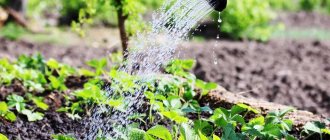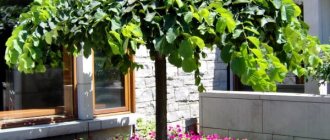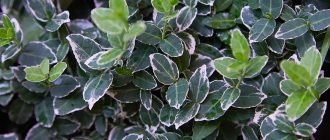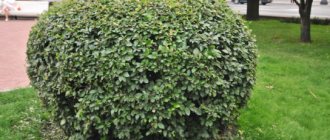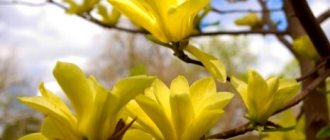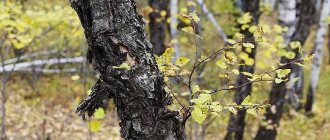Wintergreen (lat. Pyrola) is a genus of herbaceous plants of the Ericaceae family. The genus includes 40 species. Common names are umbrella winterweed, blackleaf, live grass, may grass, wild incense, light grass or pear grass. The genus is circumpolar boreal. Representatives of the genus are found naturally in the temperate and arctic zones of the Northern Hemisphere. Only four species grow in Russia. Typical places are coniferous and deciduous forests.
Characteristics of culture
Wintergreen is a perennial plant with a branched and long rhizome, from the nodes of which above-ground stems and adventitious roots are formed. The stem of the plant is thinly ribbed, up to 30-40 cm high. The leaves are leathery, hard, glossy, round, oval or ovoid, crenate or entire, sit on petioles, collected in a rosette.
The flowers are drooping or rejected, collected in sparse, straight racemes. The corolla is white, fragrant, five-petaled, spherical or goblet-shaped. The petals are thickened, concave, obtuse, rounded-ovate. The pedicels are long, formed from the axils of the bracts. The fruit of wintergreen is a drooping capsule.
The crop blooms in June-July, the fruits ripen in August-September, which largely depends on the climatic conditions of cultivation. Almost all representatives of the Wintergreen genus are characterized by symbiosis with fungi, and first of all this concerns the early stages of crop development, because the seeds feed mycorially during germination.
Growing conditions
Wintergreens prefer shady areas with moist, loose, sandy and slightly acidic soil. The presence of fungal hyphae in the soil is necessary, since plants are in symbiosis with fungi. Such soil can be brought to the site from places where wintergreen grows naturally. You can use fallen leaves or peat to acidify the soil. A layer of the listed natural materials is laid as mulch in the near-stem zone.
Reproduction
Maintenance is standard: watering, loosening, weeding and fertilizing. Although the last procedure is optional. Mulching immediately after watering will keep the soil moist for a longer time and free of weeds.
Application
Wintergreen is ideal for creating shady flower beds. Among the representatives, the most decorative species is considered to be the round-leaved wintergreen; during flowering it pleases the eye with lush inflorescences consisting of carved white flowers. The plant is widely used in folk medicine. Decoctions and infusions from the aerial parts of wintergreen are used in the treatment of headaches, inflammation of the bladder, kidney diseases, as well as rheumatism and dropsy.
Wintergreen is used as an antipyretic and antibacterial agent. Rinsing the mouth with infusions of wintergreen leaves helps get rid of bad breath from other diseases (stomatitis, periodontal disease, etc.). Infusions are useful for shortness of breath and severe fatigue. The value of the herb in question is obvious, because it contains a large amount of vitamins, minerals and flavonoids.
Summer residents often use ornamental shrubs to decorate their garden plots. There are many of them, they are unpretentious, are considered universal, and are not tied to one region. They can be seen both in Siberia and the Urals. There are sun-loving, shade-tolerant, wild-growing, tall varieties. There are usually no difficulties with selecting crops that match the type and color.
When planting ornamental shrubs, gardeners pursue several goals at once: the first is to create a unique landscape, the second is to protect low-growing plants from wind, dust and hot sun. When planning the design, be sure to take into account the need of shrubs for “personal” space.
They require more space than other garden plants.
Varieties of ornamental shrubs
The classification is based on the characteristic features of ornamental shrubs. Among them are light-loving properties, color, shape and density of the crown, appearance, and height. The last indicator is of particular importance when creating a hedge. In this case, bushes can have not only flowers, but also thorns.
Based on these factors, flowering, fruiting, low-growing and frost-resistant shrubs are distinguished. They are also classified according to the time of year. Gardeners who prefer spring varieties can plant forsythia, almond, spirea, serviceberry and kerria.
Jasmine, barberry, hydrangea and rose have a high level of decorativeness in summer. In autumn, the garden plot can be decorated with abelia, viburnum, rowan and hawthorn.
The winter garden will gain charm with rose hips, holly and yew. In areas with mild climates, plants such as Japanese maple, camellia, azalea, magnolia and witch hazel are quite popular.
Cherry plum
While decorative cherries evoke universal admiration, plums are unfairly forgotten. Hardy, still retaining the status of a fruit plant, but at the same time blooming no less spectacularly, ornamental plums also boast a considerable selection of foliage color options. And if you should start with some non-standard plum, then this is definitely the original cherry.
Cherry plum (Prunus cerasifera). ©PlantMaster
Cherry plum (Prunus cerasifera) is a beautifully flowering, original fruit-bearing, decorative deciduous, slow-growing tree. Its maximum height is about 7 m, but such a cherry plum can only be seen in nature. Garden old varieties are limited to 3–5 m, all modern cultivars most often do not grow higher than 3 m.
Ornamental shrubs for the Moscow region
In the Moscow region, winter lasts for 5 months. Only the most frost-resistant ornamental shrubs can survive such long-term exposure to low temperatures. It is desirable that they be unpretentious; we will write about them in the next section.
Additional conditions include adaptability to gas pollution and belonging to annuals. In summer, problems with growing usually do not arise. In areas with a temperate continental climate, the average air temperature is not lower than +21 °C.
Waxweed in landscape design
The decorative advantages of waxweed allow it to be used as a landscaping plant for flower beds and courtyards. It is advisable to move indoor varieties to the balcony in the summer heat to refresh the bushes. The sun's rays will benefit the plant. Pots are placed on the terrace or on the border of garden paths. With the arrival of the first cold weather, the flower is brought back into the room.
Voskovnik is friends with representatives of the flora of Mediterranean countries. Low-growing varieties are suitable for decorating borders and curtains on a lawn carpet. The bluish stems will contrast with the bright inflorescences of petunia, pelargonium and verbena. Monochromatic compositions also look good. Blue fescue will be a good neighbor for this annual.
When cut, flowering stems remain fresh for a long time. In some varieties, the buds do not fade for 3 weeks if you regularly change the water in the vase and trim the tips of the shoots.
Garden flowers Perennial flowers
Winter-hardy ornamental shrubs
This category includes shrubs and subshrubs that retain their decorative value throughout the year. They are characterized by resistance to strong winds and cold winters.
Lilac
It has a rich aroma, bright foliage and original color. There are many varieties. During the flowering period, they decorate the garden plot with lilac, white and pink tassels. Particularly popular is lilac, whose inflorescences are characterized by mixed shades.
Chubushnik
It is often called jasmine. Its advantages include bright white corollas, an alluring scent, abundant flowering, ease of care and endurance. The Snow Storm variety is often planted in gardens and park areas. Its main feature is terry corollas.
Clematis (clematis)
Decorative vines with flowers of various colors can be purple, pink, blue, lilac, crimson, burgundy and white. They decorate alpine slides and hedges. The diameter of the corollas is from 8 to 20 cm. Their shape also varies: terry, star-shaped and bell-shaped.
Spirea
As a result of abundant flowering, the plant is covered with pink and white corollas. Different varieties are often not similar to each other. Large and compact inflorescences become the main decoration of the spring garden. They can grow in both partial shade and sun.
Hydrangea
In the middle zone, only winter-hardy varieties can be grown. Beauties, whose homeland is the southern regions, are not able to survive in conditions of a sharply continental climate. Among the distinctive features are high decorativeness, impressive inflorescences, and luscious foliage. Spreading and spherical bushes are decorated with red, white, and blue corollas.
Heather
It is a shrub characterized by a large number of branches and triangular leaves. The latter can be gray, green, brown, orange and burgundy. Each inflorescence consists of goblet-shaped flowers of lilac, bluish-white, and soft pink shades. They delight from July to November.
Buddleya
Perennial with bright colors. Outwardly it resembles terry lilac. The length of the brushes often reaches 45 cm. The height of the bush is about 3 m. Thanks to the wide range of shades, the landscape with its help becomes much more impressive.
Evergreen shrubs for the garden
Among the most popular species that remain green in winter are:
- Aukubu is a beautiful poisonous shrub that reaches 2 m in height;
- Strawberry tree - after the appearance of pink and white corollas, fruits are formed that taste like wild berries;
- Boxwood - there are both tall and miniature varieties;
- Callistemon - long leaf blades, dark pink or lemon yellow inflorescences;
- Choisia - rounded crown shape, alluring aroma;
- Cistus - characterized by fleeting blooms and bright foliage.
Description of the wax plant
The stem is weakly branched. Thin root layers lie close to the surface. The shoots are straight. Mature bushes at the peak of development do not exceed half a meter in length.
The leaves are triangular or heart shaped. The ends of the plates are rounded. The foliage densely clings to the wavy shoots. The outer side of the leaf contains a waxy coating and shimmers in the sun. The annual plant received its name due to this feature. The color of the ground part is greenish-violet. A convex vein runs through the center of the plate. The top is intensely colored. The leaves are about 15 cm in size.
Flowering is characterized by the appearance of sparse drooping peduncles, on which tubular protruding buds are formed. The length of the petals is approximately 3 cm. The flowers are colored yellow and purple. Full opening of the buds occurs one by one. New flowers replace the old ones. First, the lower tier of buds blooms, and then the upper inflorescences bloom. The flowering phase lasts from June to October.
Withered buds turn into small, round, bone fruits. The base of the fruit is flat, the black skin is smooth and spotted with a gray tint. The diameter of one drupe is no more than 5 mm.
Variegated shrubs for the garden
Garden crops that are distinguished by atypical colors are considered variegated. They dilute monochromatic compositions, thereby increasing decorativeness.
Derain
An evergreen shrub characterized by white flowers and bright foliage. In autumn, blue drupes appear on it. The plant retains its decorative properties even in winter. Its shoots, painted in green, burgundy, yellow and bright red shades, make the garden more picturesque. Derain is unpretentious and frost-resistant.
Holly
Deciduous plant, decorated with berry-shaped fruits and axillary-type inflorescences. The shrub loves moisture and tolerates shade well. Doesn't adapt well when transplanted. To give the crown the required shape, pruning is carried out.
Weigela
Belongs to the Honeysuckle family. 10 varieties are grown for decorative purposes. They are deciduous shrubs that are easy to care for. Among the characteristic features are bell-shaped and funnel-shaped flowers, petiolate leaves, and an erect stem.
Hazel
The height of the bush is 7 m. The crown has an ovoid or spherical shape. The large leaves are serrated along the edges. After flowering, dark brown nuts are formed. They ripen towards the end of summer.
Skumpia
It is distinguished by fluffy inflorescences and brightly colored leaves. They can be burgundy, yellow, red, orange and even scarlet. The latter are especially noticeable in the autumn. Skumpia is classified as a member of the Sumakhov family. Both types are characterized by high decorativeness.
Bladderwort
This ornamental shrub will decorate any garden. Its spherical crown consists of spreading branches decorated with large leaf blades. Caring for the bladderwort does not take much time. It is unpretentious to soil and air. The shrub can be planted next to roads. His appearance will not suffer from this.
Where to plant roses?
If you are going to plant roses in your garden, you need to take a responsible approach to choosing a planting location. A rose grows in one place for a very long time, like any tree or shrub, therefore, the place must be chosen for it based on its requirements.
For a future rose garden, a garden plot with a slight slope to the south, protected from the north and northeast wind, is suitable. Ideally, the first half of the day the roses will be fully illuminated by the rising morning sun, and in the second half of the day they will be covered by lacy penumbra.
Rowan in the garden
Mountain ash
(Sorbus aucuparia) is a very beautiful tree, especially in single plantings. Alleys of rowan trees along the roads also make a great impression. The Latin name aucuparia comes from the merger of two: avis - bird and capere - to attract, lure, catch. People noticed that rowan fruits were attractive to birds and began to use them as bait to catch birds.
Growing weigela
Do you want to decorate your garden? Plant weigela, you won’t regret it!
Weigela
- an ornamental deciduous shrub, with rather large funnel-shaped or bell-shaped flowers, collected in loose inflorescences, belonging to the genus of shrubs of the Honeysuckle family (Caprifoliaceae).
Large-leaved hydrangea: cultivation and care
Hydrangea largeleaf
(Hydrangea macrophylla) - in places favorable for growth, it grows into a real shrub.
Hydrangea is also called hydrangia
, which translated from Greek means a vessel with water, which means that hydrangea is a moisture-loving plant. There are 80 species of hydrangeas in the world, distributed in America and East Asia.
Polyantha roses from seeds
Rose polyanthus
(Rosa polyantha nana) low perennial shrub. Of course, nothing is easier than propagating a polyanthus rose by cuttings, and even in the summer, when you poke any stick into the ground and it will bloom, you say. I also share this opinion. After all, polyanthus rose is very easy to propagate from cuttings. And in the store, while looking through a box of packets of seeds, my gaze accidentally fell on a bag of seeds of this same polyanthus rose. A hurricane of thoughts flashed through my head: oh well, we already know, it’s a divorce; and before: what if there is a rose of such unprecedented beauty and color that I don’t have yet? Naturally, I didn’t miss this chance, and the bag safely ended up in my bag.
Exotic shrubs for the garden
Each garden plot can be made unique. To create an unusual landscape design, you need to plant exotic plants that match the preferences of the summer resident. Their list is quite extensive.
tree peony
It belongs to the same genus as herbaceous perennial, etc. Peony. The height of the bush is no more than 1.5 m. The flowers decorating the bushes are pink, burgundy and yellow. Corolla diameter 30 cm.
Double flowers vary in color. The number of shoots on one plant is from 3 to 5. The width of the bushes can reach 2 m. Among the distinctive features are a charming aroma, unpretentiousness, and resistance to adverse weather conditions.
Camellia
The flowers of this plant consist of dense petals. The spectrum contains all shades of red and cream. Mixed color camellias are similar to gardenias. The oval leaf blades have a leathery surface.
Hibiscus (Chinese rose)
The assortment of specialized stores includes annual and perennial varieties. The former are flowering plants, the latter are shrubs. During the flowering period, the bushes are covered with bright, large corollas.
Acacia
The plant, which attracts bees with its unusual aroma, belongs to the legume family. Height 30 m. Features include white inflorescences and thorns on the branches.
Rhododendron
Quite whimsical. Needs an acidic environment, moisture and fertilizers. Frost-resistant varieties and their hybrids are suitable for growing in the Moscow region.
Reproduction methods
The waxweed reproduces by seed and vegetative methods. Cultivation of waxweed from seeds begins in February. To do this, seedlings are first sown. The seeds are first laid out on a wet cloth for a day, and then deepened 1-1.5 cm into the garden soil mixture. A distance of 4-5 cm should be left between the drupes. Germination takes 10-15 days. Interestingly, two plants sprout from each seed.
Young plants need good lighting and periodic watering. The optimal temperature is +15…+20 °C. After 2 weeks, the grown seedlings are suitable for planting in the garden. A distance of 25 cm is maintained between plants. At the end of April, waxweed can be sown in open ground. In this case, flowering will begin in the second half of July.
Hybrid varieties and indoor forms are propagated by cuttings, this makes it possible to preserve varietal differences. Young shoots are cut from the top of the bush and soaked in a growth stimulator, and a day later they are planted in the ground.
Fruit bushes for the garden that can be used as decorative
They can be seen in every garden plot. By planting them, the summer resident receives not only an interesting element of landscape design, but also tasty, healthy berries. This versatility is both a plus and a minus. This is due to more complex care. If agrotechnical requirements are not met, the harvest is unlikely to be abundant. Fruit bushes should be planted in autumn. The best time to plant is immediately after leaf fall.
Derain
A plant from the Dogwood family, characterized by winter hardiness and unpretentiousness. You can plant silky, blood-red and white turf on your garden plot. The height of the ornamental shrub does not exceed 3 m.
Thanks to its compact shape and abundant flowering, turf can decorate even a small garden. Ripe fruits do not have a pleasant taste.
Euonymus
It is classified as an evergreen plant. Characteristic features include oblong leaves, raceme-shaped inflorescences and fiery fruits. Even after leaf fall, it retains its decorative effect.
White dogwood (Cornus alba)
White dogwood (or white dogwood) is a favorite plant in autumn and winter mixborders. Its cherry-red shoots will add bright accents to a “dormant” garden. For example, we have already offered the option of a beautiful flower garden with dogwood, heather, Erica and herbs.
In one season, this shrub changes its “outfit” several times. In late spring and summer, it is “dressed” in green and white: the foliage is strewn with small brushes with a diameter of 5 cm, collected from tiny whitish-cream inflorescences. In autumn the leaves turn yellow, and the deren greets the arrival of winter in a red “suit”.
The fruits of this tree ripen in mid-summer. They are usually white, but in some varieties they take on a bluish-blue tint.
Sometimes white derain blooms again in the summer.
The bush will not give you any trouble: it does not get sick, is not afraid of frost, drought and slight flooding.
The height of an adult plant is 2.4-3 m.
It is worth considering that pruning the tree depends on your plans for its participation in the garden “symphony”. If you want to achieve maximum showiness in winter, you need to encourage the bush to branch. To do this, cut a third of the old shoots to the ground in early spring. If you want the turf to bloom and bear fruit, do not prune young shoots.
There are various cultivars of white dogwood. The most popular of them are Elegantissima, which is notable for its green foliage with a white border, Aurea with golden leaves, Sibirica with bluish fruits.
Mr. Summer Resident: basic tips for planting shrubs
Before planting, you need to choose a place to create a new composition. At this stage, you should focus on agrotechnical requirements. Seedlings of variegated varieties need plenty of sunlight.
Crops that are uniform in color are mostly shade-loving. Plants can be planted either individually or in a group. The ideal option is a composition of three ornamental shrubs.
Landing is carried out as follows:
- Prepare the soil (digging, removing stones and debris, applying fertilizers).
- Make holes for seedlings.
- Garden plants are planted.
The distance between the bushes depends on the size to which the bush grows. The remaining space can be filled with rhizomes and bulbous crops. If these recommendations are ignored, they will interfere with each other.
Shrubs are planted near fences and outbuildings. In flower beds they can be placed both in the center and in the back row. Each option is original in its own way. An exclusive ensemble of garden plants of different heights will become the “highlight” of your garden plot.
How to choose ornamental and fruit and berry bushes
The range of crops that are planted to decorate the garden is quite extensive. Among the determining factors are:
- personal preferences of the summer resident;
- garden plot area;
- estimated location of the bushes;
- difficulty of care;
- soil and climatic conditions;
- life span of the shrub (annual and perennial);
- compatibility with other garden crops to avoid dissonance between colors, aromas and shapes;
- decorative features.
Lush, spreading bushes are suitable for creating a landscape park. For those who have a small plot, these are unlikely to be suitable. In this case, they give preference to minimalist compositions, choosing varieties that can take any form. Their distinctive feature is the absence of problems with cutting.
Seedlings of decorative deciduous trees and shrubs. Catalog of varieties with photos and descriptions. Trees and shrubs from the best nurseries.
Special prices apply to a select range of products. The number of promotional items is limited.
